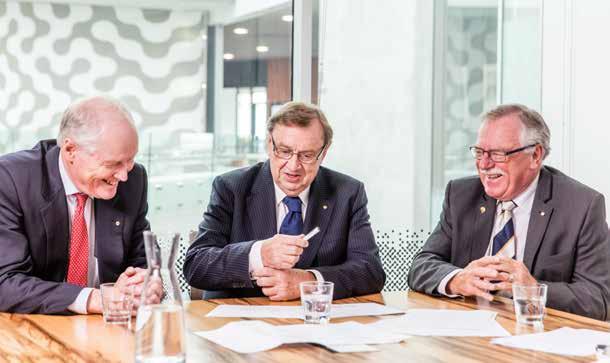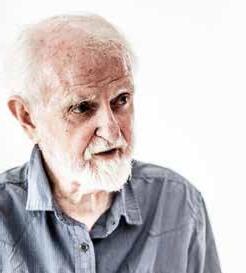
4 minute read
WELCOME TO THE FLOREY ANNUAL
from the Chairman, the Director and the Foundation Chairman
Cover image: Collingwood star Travis Cloke is helping the Florey promote brain research.
The star forward met Florey offspring, Ivaan Sethi, William and Kate Portbury, and Luka Tse Farrell while celebrating a new community partnership between Collingwood and the Florey. After a brilliant start to the relationship, when the Pies beat Richmond by one point in Round 2, we are looking forward to another Florey Brain Game in 2017.
To donate
Text BRAIN to 0437 371 371
Phone: 1800 063 693
Online: florey.edu.au
Post: The Florey Reply Paid 83037
30 Royal Parade, Parkville VIC 3052
Acknowledgements
Editor: Amanda Place
Text: Amanda Place, Tom Keeble, Anne Crawford, Shane Green, Nick Place
Design: Blueboat
Photography: Mark Chew, Peter Casamento and Michael Findlay
Proofreading: Jane Standish and Margit Simondson
Published May 2016
Highlights of the Florey’s laboratory and clinical research can be found by visiting our website at florey.edu.au
For copies of this report and comments, please email amanda.place@florey.edu.au
Welcome to the Florey’s latest – full of scientific highlights from the past year. With some 600 people contributing to the Florey’s brain research, it is always inspiring to stand back and marvel at the depth of knowledge and the commitment displayed by our talented scientists. We are a unified and determined lot, committed to improving the human condition through neuroscience. Many of us feel a deep sense that we are in the right place at the very right time. There is no doubt that the brain is the most exciting organ to be investigating in modern medicine. Around the world, neuroscientific discovery is advancing at a cracking pace.
When we expand our focus beyond our laboratories and consider the contribution of neuroscience to the Australian population, there is much to celebrate.
As Australia develops a more sophisticated economy, it is worth noting that the sciences – physical, mathematical and biological – support more than 1 million jobs, or 10 per cent of our total employment.
The benefits are of course measurable in dollar terms but once we add the human factor, the impact is truly immeasurable. Medical research changes lives – not simply one person at a time but across entire populations. We find the causes of diseases; we discover medications to prevent or treat; we investigate the way the human mind behaves and we seek ways to modify and repair. Innovative medical research, with its commercial opportunity, is critical to Australia’s prosperity.
The Florey has enjoyed another year of discovery and progress to help people. Our scientists have weathered the insecurity of declining government funding. The National Health and Medical Research Council (NHMRC) is funding just 14 per cent of the projects it deems worthy of support. This means brilliant research programs cannot proceed. Despite this environment, we have secured several large NHMRC project and program grants that will offer a level of security to individual teams as they investigate stroke, Alzheimer’s and other diseases including motor neurone disease.
We are determined to produce exceptional science. We are always looking further afield for funding, recognising the fragile nature of government support.
The US Defense Department, through its Defense Advanced Research Projects Agency (DARPA), has been a key source of funding for brilliant projects that ‘think outside the box’ and often involve bionics. Enormous potential is realised and truly novel thinking pays off. These projects are powering ahead. The story on page 19 showcasing a stent-based electrode to help paralysed people move their limbs is a case in point.
Another DARPA grant seeks to understand the role of the brain in gut disease, with the aim of inventing a bio-electronic implant to treat inflammatory bowel diseases and post-traumatic stress.
We are extraordinarily grateful to our philanthropic partners, Trusts and Foundations, and valued donors who help us take our discoveries beyond the basic to the exceptional. Without your support, we simply could not operate at an international level.
While there is great excitement and hope for the Medical Research Future Fund, it remains exactly that, a fund for the future. We hope the Federal Government continues to build the endowment, as promised, so it delivers realistic funding by 2022. If fully executed, this $20 billion fund will change the face of medical research and will propel Australian research in a dramatic way, attracting talent and securing our own as we seek healthier lives for people across the globe.
Once again, the Florey has been named as the home of Australia’s most cited neuroscientists – Professors Colin Masters and Ashley Bush. They lead a team that includes several Florey Honorary professionals who set the pace in the field of Alzheimer’s disease and mental illness. Collaborations with colleagues in nearby hospitals and research facilities build a dynamic environment for discovery while improving patient care.
Finally, we would like to acknowledge the enormous efforts of the Florey Board during a time of consolidation and growth. Also, thank you to the Foundation Council members who have worked with our fundraising team to build our profile and to generate interest in our work. Thank you, also, to our dedicated scientists and our generous supporters.
Please enjoy reading this magazine and know you help make discoveries happen.
BREAKTHROUGHS IN BRAIN HEALTH ARE WITHIN SIGHT.
Our 20-year plan aims to:
Diminish
The Scourge Of Dementia
Prevent stroke and limit its impact when it does occur
Reduce the incidence and devastation caused by mental illness
Identify and help those genetically prone to epilepsy.
Dr Brian Stevens is a Florey stalwart who turns 87 in July. This dedicated scientist’s 60-year career has been punctuated by creative invention as he has endeavoured to reveal the processes behind human disease.

These days, he focuses on ways to reveal the fundamental secrets within the brain when neurodegenerative illnesses like Alzheimer’s and Parkinson’s diseases relentlessly progress. His depth of experience in atomic chemistry and his contribution to modern analytical techniques is profound.
Brian was not only present during the early development of a technique known as atomic









